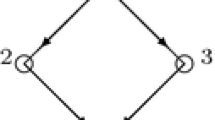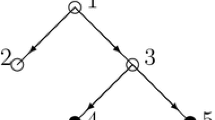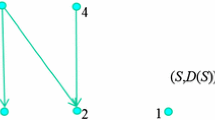Abstract
It is known that peer group games are a special class of games with a permission structure. However, peer group games are also a special class of (weighted) digraph games. To be specific, they are digraph games in which the digraph is the transitive closure of a rooted tree. In this paper we first argue that some known results on solutions for peer group games hold more general for digraph games. Second, we generalize both digraph games as well as games with a permission structure into a model called games with a local permission structure, where every player needs permission from its predecessors only to generate worth, but does not need its predecessors to give permission to its own successors. We introduce and axiomatize a Shapley value-type solution for these games, generalizing the conjunctive permission value for games with a permission structure and the \(\beta \)-measure for weighted digraphs.
Similar content being viewed by others
Notes
Every coalition having a unique largest feasible subset follows from the fact that \(\varPhi ^c_D\) is union closed.
In van den Brink and Gilles (2000) a similar game and measure are defined, but a node does not “share” in the power over itself, i.e., they consider the game \(v^\prime _{\delta ,D}(E) = \sum \nolimits _{\stackrel{i \in N}{P_D(i) \subseteq E}} \delta _i,\;E \subseteq N\), having Shapley value \(\beta ^\prime _i(D) = S\!h_i(v^\prime _{\delta ,D}) = \sum \nolimits _{j \in S_D(i)} \frac{\delta _j}{|P_D(j)|}\). A disadvantage of this measure is that a node can do better in the associated ranking after “being defeated” by more other nodes.
We refer to the mentioned literature for definitions of the solutions.
In most models of restricted cooperation, such as the communication graph games of Myerson (1977), and its generalization to games on union stable systems in Algaba et al. (2000, 2001), it is the case that the worth of a feasible coalition in the restricted game equals the worth of this coalition in the original game.
For the conjunctive approach, Gilles et al. (1992) introduce the authorizing set of \(E\) as \(\alpha ^c_D(E)=E \cup \widehat{P}_D(E)\) which is the smallest conjunctive feasible set containing \(E\).
We want to remark that the generalization of games with a permission structure to games with a local permission structure is different from the generalization to games on antimatroids (see Algaba et al. 2003, 2004a, b) which considers cooperative games with restricted coalition formation where the set of feasible coalitions is an antimatroid. The set of locally feasible coalitions is not an antimatroid.
This game is similar to one of the ‘collusion’ games in Haller, the proxy agreement game \(v_*^{ij}\), where \(v_*^{ij}(E)=v(E \setminus \{j\})\) if \(E \subseteq N \setminus \{i\}\), and \(v_*^{ij}=v(E \cup \{j\})\) if \(i \in E\). So, the difference is that in \(v^{ij}_*\) player \(j\) is active if player \(i\) is present even when \(j\) itself is not.
Also, if \(D\) is acyclic then \(\varPhi ^d_D\) is union closed.
References
Algaba, E., Bilbao, J. M., Borm, P., & López, J. J. (2000). The position value for union stable systems. Mathematical Methods of Operations Research, 52, 221–236.
Algaba, E., Bilbao, J. M., Borm, P., & López, J. J. (2001). The Myerson value for union stable structures. Mathematical Methods of Operations Research, 54, 359–371.
Algaba, E., Bilbao, J. M., van den Brink, R., & Jiménez-Losada, A. (2003). Axiomatizations of the Shapley value for cooperative games on antimatroids. Mathematical Methods of Operations Research, 57, 49–65.
Algaba, E., Bilbao, J. M., van den Brink, R., & Jiménez-Losada, A. (2004a). Cooperative games on antimatroids. Discrete Mathematics, 282, 1–15.
Algaba, E., Bilbao, J. M., van den Brink, R., & Jiménez-Losada, A. (2004b). An axiomatization of the Banzhaf value for cooperative games on antimatroids. Mathematical Methods of Operations Research, 59, 147–166.
Ambec, S., & Sprumont, Y. (2002). Sharing a river. Journal of Economic Theory, 107, 453–462.
Bondareva, O. (1963). Some applications of linear programming methods to the theory of cooperative games. Problemy Kibernetiki, 10, 119–139. (in Russian).
Brânzei, R., Fragnelli, V., & Tijs, S. (2002). Tree-connected peer group situations and peer group games. Mathematical Methods of Operations Research, 55, 93–106.
Curiel, I., Potters, J., Prasad, V. R., Tijs, S., & Veltman, B. (1993). Cooperation in one machine scheduling. ZOR: Methods and Models of Operations Research, 38, 113–129.
Curiel, I., Potters, J., Prasad, V. R., Tijs, S., & Veltman, B. (1994). Sequencing and cooperation. Operations Research, 54, 323–334.
Derks, J., Haller, H., & Peters, H. (2000). The selectope for cooperative TU-games. International Journal of Game Theory, 29, 23–38.
Gilles, R. P., & Owen, G. (1994). Cooperative games and disjunctive permission structures. Blacksburg, Virginia: Department of Economics, Virginia Polytechnic Institute and State University.
Gilles, R. P., Owen, G., & van den Brink, R. (1992). Games with permission structures: The conjunctive approach. International Journal of Game Theory, 20, 277–293.
Gillies, D. B. (1953). Some theorems on n-person games. Ph.D. Thesis, Princeton University Press, Princeton, NJ.
Graham, D., & Marshall, R. (1987). Collusive behavior at single-object second-price and english auctions. Journal of Political Economy, 95, 1217–1239.
Graham, D. A., Marshall, R. C., & Richard, J. F. (1990). Differential payments within a bidder coalition and the Shapley value. American Economic Review, 80, 493–510.
Harsanyi, J. C. (1959). A bargaining model for cooperative \(n\)-person games. In A. W. Tucker & R. D. Luce (Eds.), Contributions to the theory of games IV (pp. 325–355). Princeton, NJ: Princeton University Press.
Littlechild, S. C., & Owen, G. (1973). A simple expression for the Shapley value in a special case. Management Science, 20, 370–372.
Maniquet, F. (2003). A characterization of the Shapley value in queueing problems. Journal of Economic Theory, 109, 90–103.
Maschler, M. (1992). The bargaining set, kernel, and nucleolus. In R. J. Aumann, & S. Hart (Eds.), Handbook of game theory, with economic applications (Vol. 2, pp. 591–667). Amsterdam: North Holland.
Maschler, M., Peleg, B., & Shapley, L. S. (1972). The kernel and bargaining set for convex games. International Journal of Game Theory, 1, 73–93.
Myerson, R. B. (1977). Graphs and cooperation in games. Mathematics of Operations Research, 2, 225–229.
Ni, D., & Wang, Y. (2007). Sharing a polluted river. Games and Economic Behavior, 60, 176–186.
Shapley, L. (1953). A value for \(n\)-person games. In H. W. Kuhn & A. W. Tucker (Eds.), Contributions to the theory of games II (pp. 307–317). Princeton, NJ: Princeton University Press.
Shapley, L. (1967). On balanced sets and cores. Naval Research Logistics Quarterly, 14, 453–460.
van den Brink, R. (1997). An axiomatization of the disjunctive permission value for games with a permission structure. International Journal of Game Theory, 26, 27–43.
van den Brink, R. (2002). The apex power measure for directed networks. Social Choice and Welfare, 19, 845–867.
van den Brink, R. (2008). Vertical wage differences in hierarchically structured firms. Social Choice and Welfare, 30, 225–243.
van den Brink, R., & Borm, P. (2002). Digraph competitions and cooperative games. Theory and Decision, 53, 327–342.
van den Brink, R., & Gilles, R. P. (1996). Axiomatizations of the conjunctive permission value for games with permission structures. Games and Economic Behavior, 12, 113–126.
van den Brink, R., & Gilles, R. P. (2000). Measuring domination in directed networks. Social Networks, 22, 141–175.
van den Brink, R., & Ruys, P. H. M. (2008). Technology driven organizational structure of the firm. Annals of Finance, 4, 481–503.
Vasil’ev, V. A., & van der Laan, G. (2002). The Harsanyi set for cooperative TU-games. Siberian Advances in Mathematics, 12, 97–125.
Williamson, O. E. (1967). Hierarchical control and optimum firm size. Journal of Political Economy, 75, 123–138.
Acknowledgments
Chris Dietz is financially supported by NWO Grant 400-08-026.
Author information
Authors and Affiliations
Corresponding author
Rights and permissions
About this article
Cite this article
van den Brink, R., Dietz, C. Games with a local permission structure: separation of authority and value generation. Theory Decis 76, 343–361 (2014). https://doi.org/10.1007/s11238-013-9372-5
Published:
Issue Date:
DOI: https://doi.org/10.1007/s11238-013-9372-5




